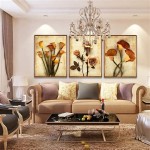Modern Home Decorating Ideas: A Comprehensive Guide
Modern home decor emphasizes clean lines, functionality, and a minimalist aesthetic. It favors open spaces, natural light, and a neutral color palette punctuated by strategic pops of color. Designing a modern home requires a thoughtful approach, carefully balancing form and function to create a space that is both visually appealing and highly livable. This article explores several key aspects of modern home decorating, offering ideas and guidance to help achieve a sophisticated and comfortable living environment.
Embracing Minimalism and Decluttering
At the heart of modern decor lies the principle of minimalism. This involves consciously reducing the number of items in the home, focusing on essentials and carefully curated accent pieces. Decluttering is a crucial first step in achieving a modern aesthetic. This process requires a critical evaluation of possessions, discarding items that are no longer needed or used regularly. Consider donating, selling, or responsibly disposing of unwanted belongings.
Once the decluttering process is complete, attention can be turned to organizing and streamlining the remaining possessions. Utilize storage solutions that minimize visual clutter, such as closed cabinets, drawers, and storage bins. Wall-mounted shelving can provide a clean and modern look while offering functional storage space. The goal is to create a sense of spaciousness and order, allowing the design elements to stand out without being overshadowed by excessive belongings.
Furniture selection plays a significant role in maintaining a minimalist aesthetic. Opt for pieces with clean lines, simple silhouettes, and minimal ornamentation. Avoid bulky or heavily decorated furniture that can detract from the overall sense of openness. Choose furniture that is both functional and aesthetically pleasing, contributing to the overall design rather than simply occupying space.
Consider incorporating multi-functional furniture pieces to maximize space and minimize clutter. For example, a sofa bed can serve as both seating and a guest bed, while a coffee table with built-in storage can provide a convenient place to store magazines, remotes, and other small items. Maximizing the utility of each piece of furniture contributes to a more streamlined and efficient living space.
Wall decor should also be approached with a minimalist mindset. Avoid overcrowding walls with too many pictures or decorative items. Instead, focus on a few carefully chosen pieces that complement the overall design. Consider using large-scale artwork or sculptural elements to create a focal point without overwhelming the space. Mirrors can also be used to enhance the sense of spaciousness and reflect natural light.
Leveraging Neutral Color Palettes and Strategic Use of Color
Neutral color palettes are a hallmark of modern home decor. Whites, grays, beiges, and other muted tones create a clean, sophisticated, and versatile backdrop for other design elements. These neutral colors provide a sense of calm and tranquility, allowing the textures and shapes within the space to take center stage. A consistent neutral color scheme throughout the home creates a cohesive and harmonious flow from one room to another.
While neutral colors form the foundation of modern decor, carefully chosen pops of color can add visual interest and personality to the space. Strategic placement of color can draw the eye to specific areas or highlight certain design features. Accent walls, colorful throw pillows, vibrant artwork, and strategically placed accessories can introduce color without disrupting the overall minimalist aesthetic.
When selecting accent colors, consider the desired mood and atmosphere. Warm colors such as reds, oranges, and yellows can create a sense of energy and excitement, while cool colors such as blues, greens, and purples can promote relaxation and tranquility. The choice of accent colors should complement the neutral backdrop and reflect the personal preferences of the homeowner.
The 60-30-10 rule can be a helpful guideline for incorporating color into a modern decor scheme. This rule suggests that 60% of the space should be dominated by a primary neutral color, 30% should be occupied by a secondary color, and 10% should be dedicated to an accent color. This ratio ensures a balanced and harmonious color palette.
Incorporate natural elements to add warmth and texture to a neutral color scheme. Wood accents, such as hardwood floors, wooden furniture, and natural wood wall panels, can create a sense of connection to the outdoors. Plants and greenery can also add life and color to the space, while also improving air quality. The combination of neutral colors and natural elements creates a balanced and inviting atmosphere.
Maximizing Natural Light and Incorporating Modern Lighting Fixtures
Natural light is a critical element in modern home decor. Maximizing the amount of natural light that enters the home can dramatically enhance the sense of spaciousness and create a more inviting atmosphere. Large windows, skylights, and glass doors are ideal for bringing in natural light. Avoid heavy window treatments that block light; instead, opt for sheer curtains or blinds that allow light to filter through while still providing privacy.
The placement of furniture should also be considered in relation to natural light sources. Position furniture to take advantage of natural light during the day, avoiding blocking windows or creating dark corners. Light-colored walls and ceilings can also help to reflect and distribute natural light throughout the space.
In addition to natural light, modern lighting fixtures play a crucial role in creating a well-lit and visually appealing home. Choose lighting fixtures that complement the modern aesthetic, opting for clean lines, simple shapes, and minimalist designs. Recessed lighting, track lighting, and pendant lights are popular choices for modern homes.
Layered lighting is essential for creating a versatile and functional lighting scheme. This involves combining different types of lighting to achieve the desired effect. Ambient lighting provides overall illumination, task lighting is used for specific activities, and accent lighting highlights certain features or areas. A well-planned lighting scheme should incorporate all three types of lighting to create a balanced and comfortable environment.
Smart lighting systems offer a convenient and energy-efficient way to control lighting throughout the home. These systems allow you to adjust the brightness, color, and timing of lights using a smartphone or voice command. Smart lighting can also be integrated with other smart home devices to create a seamless and automated living experience.
Consider the color temperature of the light bulbs when selecting lighting fixtures. Warm white light (2700-3000K) creates a cozy and inviting atmosphere, while cool white light (3500-4100K) provides a brighter and more energetic feeling. Choose the color temperature that best suits the desired mood and function of each room.
Statement lighting fixtures can serve as a focal point in a modern home. A well-chosen chandelier, pendant light, or floor lamp can add visual interest and personality to the space. Opt for fixtures with unique designs, interesting materials, or sculptural forms to create a statement piece that complements the overall decor.

40 Contemporary Decorating Ideas For Your Home Bored Art Living Room Decor Modern Sectional Livingroom Layout

Harold Williams Haroldwilliamse Modern Apartment Design Living Room Decor Interior

Livingroom Ideas Decor Decorating Id Contemporary Living Room Luxury House Designs Open

Modern Home Decor Ideas For And Skeptics Alike

100 Modern Home Decor Ideas

45 Irresistibly Stylish Midcentury Modern Living Room Idea

77 Best Living Room Decor Ideas 2025 Unique

Simple Modern Fall Decorating Ideas Zdesign At Home

25 Tips For Decorating A Modern Home Extra Space Storage

25 Beautiful Modern Living Room Interior Design Examples Contemporary
Related Posts







